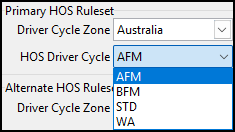TruckMate 2025.2 New Features: Operations
Framework
Updated TruckMate service setup forms across all applications (TM-125708)
The service setup windows across TruckMate have been standardized.
Previously, each TruckMate service had a different setup window. They did not include the same fields, and each had their own design. Now, every service setup window is the same, except where a service needs slightly different fields because of its requirements.
No existing service is affected by this change. After you upgrade to 25.2, your services will continue to function without issue. This change only affects the configuration of future services.
The updated service setup window’s features include:
-
A more detailed "Test DB Connection" tool. This tool gives you more information about the accounts being used to run the service.
-
The ability to give a unique Windows service name to each service.
-
A status indicator for applications that support multiple services:
-
Red: the service is installed but not running.
-
Yellow: the service is paused but still running.
-
Green: the service is active and running.
-
Gray: the service is not installed.
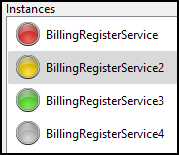
-
Here is an example of an updated service setup window from ART Server Administrator:
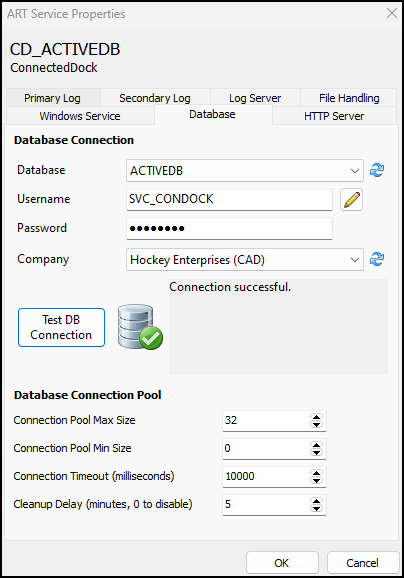
Here is an example from Billing Register. It shares a design with all the back office applications. Note that you can view all the instances in the same window:
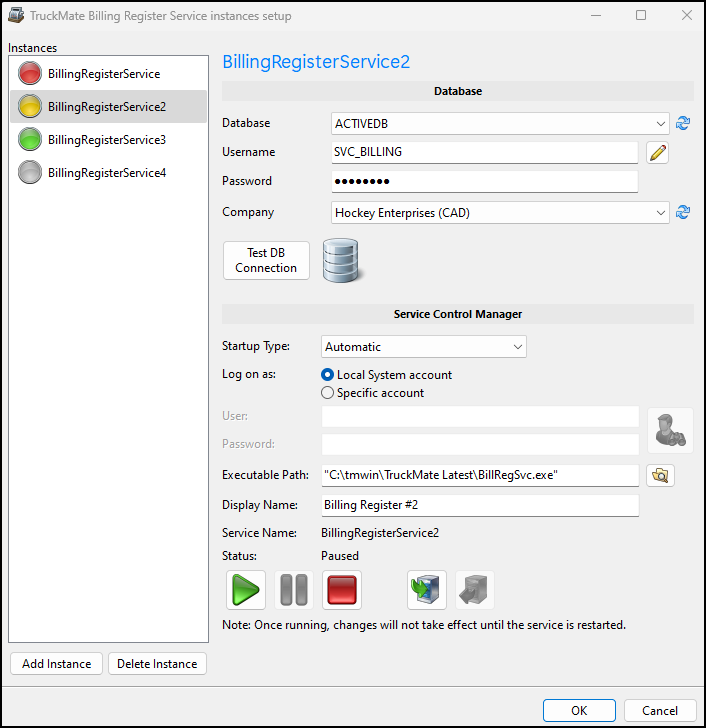
Here is an example within Scheduler Host. It shares the same design as other services, except that you can configure these services' ports.
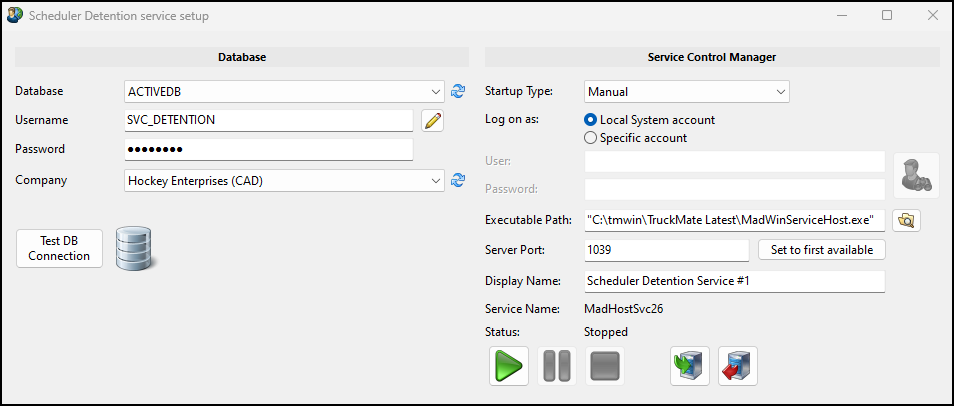
Here is an example from Mileage Service Manager. This shares the same design as other services, but it has an additional Server Job Types pane.
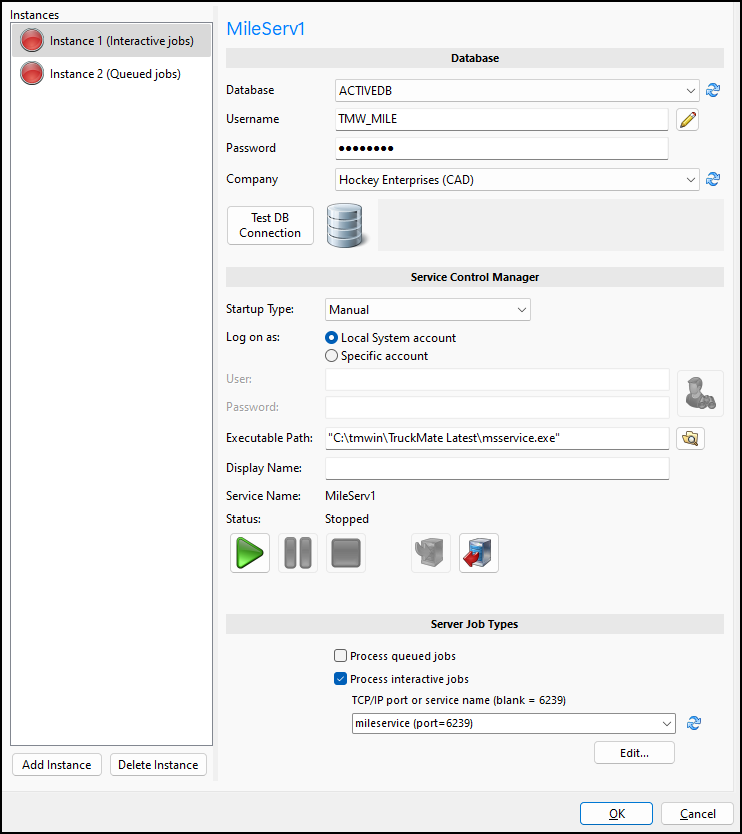
Allow adjustment of default Vendor Profile settings (TM-142032)
You can now choose the default settings for the Allowed to transport Commodities flagged as options. These are the settings that will apply to newly created vendor profiles.

Previously, these options were selected by default for new vendor profiles. Now these can be turned on or off using an app config. The app config is called PROFILES.EXE - Vendor Interliner Default Commodities Flag.

The default setting leaves these options cleared.
Updated the length of the SPEQ Column for Appian DirectRoute (TM-176011)
The SpEq (special equipment) column on the Appian workflow allows for 105 characters. On the TruckMate side, the same column on the APPIAN_ROUTE_RESPONSE table only allowed for 100 characters. This could cause errors when trying to use the integration.
To avoid these errors, the SpEq column on the TruckMate side has been increased to 255 characters.
Application Configurator cleanup (TM-177633)
Some changes have been made to Application Configurator. Sections for applications that had no options or that were deprecated have been removed.
These sections were removed:
-
AGENTDIAL.EXE
-
AGENTS.EXE
-
AIRFREIGHTDISP.EXE
-
DISPPLAN.EXE
-
DRIVERPAY.EXE
-
LOGBOOKS.EXE
-
SCHEDULER.EXE
-
SCHEDULER.PROC
-
SUPCON.EXE
-
SUPNR.EXE
Four application configuration options were moved from AMAN.EXE to MMDISP.EXE:
-
Create FB on Match
-
DateTime - FB Create
-
Skid Dimension Form
-
Trace Type to Create
The app config Restrict Status Codes when FB Active on Trip was moved from STATCHNG.EXE to MADSERVICEHOST.EXE.
Updated the user list for standard TruckMate Services Users (TM-179178)
The standard services user list in TruckMate has been updated.
Previously, the service users all started with "TMW_". This list did not account for all possible services. The username also did not clearly show that the outcome came from a service.
User IDs now start with the prefix "SVC_" instead of "TMW_".
| No previous TMW_ user accounts have been removed from the database as part of this conversion. |
Here is a table showing the default service users:
| USER_ID | USERNAME | GROUP | IS_SYSTEM_USER |
|---|---|---|---|
SVC_BILLING |
Service Account - Billing Services |
TMW_SERVICES |
True |
SVC_CALO |
Service Account - Carrier API Load Offer |
TMW_SERVICES |
True |
SVC_COMM |
Service Account - MobileComm |
TMW_SERVICES |
True |
SVC_COMMAPI |
Service Account - TruckMate API |
TMW_SERVICES |
True |
SVC_CONDOCK |
Service Account - ART - ConnectedDock |
TMW_SERVICES |
True |
SVC_CONTAINERIQ |
Service Account - Container IQ |
TMW_SERVICES |
True |
SVC_DAWG |
Service Account - Scheduler Dawg |
TMW_SERVICES |
True |
SVC_DETENTION |
Service Account - Scheduler Detention |
TMW_SERVICES |
True |
SVC_DRIVERPAY |
Service Account - DriverPay Services |
TMW_SERVICES |
True |
SVC_EDI |
Service Account - EDIComMgr |
TMW_SERVICES |
True |
SVC_EDIUPD |
Service Account - EDI Update |
TMW_SERVICES |
True |
SVC_EMAIL |
Service Account - Scheduler Email |
TMW_SERVICES |
True |
SVC_EXPORT |
Service Account - Export Services |
TMW_SERVICES |
True |
SVC_EXPORTWIZ |
Service Account - Export Wizard |
TMW_SERVICES |
True |
SVC_FBIMPORTER |
Service Account - FB Importer |
TMW_SERVICES |
True |
SVC_FINANCE |
Service Account - ART - Finance |
TMW_SERVICES |
True |
SVC_FUEL |
Service Account - Fuel Services |
TMW_SERVICES |
True |
SVC_HOS |
Service Account - HOS Services |
TMW_SERVICES |
True |
SVC_IMAGING |
Service Account - ART - Imaging |
TMW_SERVICES |
True |
SVC_IPACCRUAL |
Service Account - IP Accrual |
TMW_SERVICES |
True |
SVC_IPAUDIT |
Service Account - IP Audit |
TMW_SERVICES |
True |
SVC_MAPS |
Service Account - Trimble Maps Service |
TMW_SERVICES |
True |
SVC_MASTERDATA |
Service Account - ART - MasterData |
TMW_SERVICES |
True |
SVC_MILE |
Service Account - Mileage Service |
TMW_SERVICES |
True |
SVC_OUTOFBAND |
Service Account - Out of Band |
TMW_SERVICES |
True |
SVC_PAYROLL |
Service Account - Payroll Services |
TMW_SERVICES |
True |
SVC_REST |
Service Account - ART - Rest API |
TMW_SERVICES |
True |
SVC_RETENTION |
Service Account - Driver Retention |
TMW_SERVICES |
True |
SVC_RMIS |
Service Account - RMIS |
TMW_SERVICES |
True |
SVC_SCHANGER |
Service Account - Status Changer |
TMW_SERVICES |
True |
SVC_SCHEDULER |
Service Account - Scheduler Proc |
TMW_SERVICES |
True |
SVC_TEMPLATES |
Service Account - Templates Service |
TMW_SERVICES |
True |
SVC_TMT |
Service Account - TMT |
TMW_SERVICES |
True |
SVC_TTCIMPORT |
Service Account - TTC Import |
TMW_SERVICES |
True |
SVC_VISIBILITY |
Service Account - ART - Visibility |
TMW_SERVICES |
True |
SVC_WEB |
Service Account - TM4Web |
TMW_SERVICES |
True |
SVC_MONITOR |
TruckMate Monitoring Service Account |
MONITORING |
True |
TMW_SUPPORT2 |
Generic Trimble Account #2 |
TMWINGRP |
False |
TMW_SUPPORT3 |
Generic Trimble Account #3 |
TMWINGRP |
False |
Here is a table listing all the TruckMate services and which user to use with them:
| TRUCKMATE SERVICE | SUGGESTED SERVICE USERNAME |
|---|---|
ART - ConnectedDock |
SVC_CONDOCK |
ART - Freight Bill Import |
SVC_FBIMPORTER |
ART - TruckMate Rest API |
SVC_REST |
ART - Hours of Service |
SVC_HOS |
ART - Insurance |
SVC_RMIS |
ART - Imaging |
SVC_IMAGING |
ART - MasterData |
SVC_MASTERDATA |
ART - Finance |
SVC_FINANCE |
ART - Visibility |
SVC_VISIBILITY |
Billing Register Service |
SVC_BILLING |
Communications Manager Service |
SVC_COMM |
Driver Deduction Register Service |
SVC_DRIVERPAY |
Driver Pay Register Service |
SVC_DRIVERPAY |
EDI Communications Manager |
SVC_EDI |
Invoice Print Service |
SVC_BILLING |
IP Accrual Register Service |
SVC_IPACCRUAL |
IP Audit Register Service |
SVC_IPAUDIT |
Mileage Service |
SVC_MILE |
Statement Printing Service |
SVC_BILLING |
Storage Billing Service |
SVC_BILLING |
Timeclock Service |
SVC_PAYROLL |
TM4Web |
SVC_WEB |
TruckMate API |
SVC_COMMAPI |
TTC Import Service |
SVC_TTCIMPORT |
MWSH - BreakThrough Fuel |
SVC_FUEL |
MWSH - Carrier API Load Offer |
SVC_CALO |
MWSH - Comdata |
SVC_FUEL |
MWSH - Container IQ |
SVC_CONTAINERIQ |
MWSH - Driver Retention |
SVC_RETENTION |
MWSH - EDI Order Update |
SVC_EDIUPD |
MWSH - Export |
SVC_EXPORT |
MWSH - Export Wiz |
SVC_EXPORTWIZ |
MWSH - FB Import |
SVC_FBIMPORTER |
MWSH - FleetOne |
SVC_FUEL |
MWSH - MJ Ervin Fuel Cost Import |
SVC_FUEL |
MWSH - Omnitracs HOS |
SVC_HOS |
MWSH - QuikQ |
SVC_FUEL |
MWSH - Omnitracs Portal |
SVC_COMM |
MWSH - Out of Band Process |
SVC_OUTOFBAND |
MWSH - PplNet Module |
SVC_COMM |
MWSH - RMIS Module |
SVC_RMIS |
MWSH - Scheduler Dawg |
SVC_DAWG |
MWSH - Scheduler Detention |
SVC_DETENTION |
MWSH - Scheduler Email |
SVC_EMAIL |
MWSH - Scheduler Run DLL |
SVC_SCHEDULER |
MWSH - Scheduler Stored Proc |
SVC_SCHEDULER |
MWSH - Status Changer |
SVC_SCHANGER |
MWSH - TCH |
SVC_FUEL |
MWSH - TChek |
SVC_FUEL |
MWSH - TMT Module |
SVC_TMT |
MWSH - Trimble Cloud Export |
SVC_EXPORT |
MWSH - Trimble Maps Places |
SVC_MAPS |
MWSH - TruETA Notifications |
SVC_MAPS |
MWSH - Trip Template Auto Generation |
SVC_TEMPLATES |
MWSH - Twilio SMS |
SVC_COMM |
| MWSH is the MadWinServiceHost service. |
Added condition to the Owner results list (TM-179479)
In the Container Inventory application, the Owner field’s search results previously only included clients that have the IS_STEAMSHIP flag set to True. Now, the Owner field also checks for clients that have IS_CHASSIS_OWNER set to True.
When you search for containers by owner, the results list now shows clients who have either Steamship Line or Chassis Owner selected on their vendor profile.
Added Custom Job Procedures to Out of Band (TM-181781)
The Out of Band service takes actions that would normally occur right away and instead puts them into a job queue. This puts less pressure on the system and can improve performance.
You can now set up your own procedures to run in Out of Band.
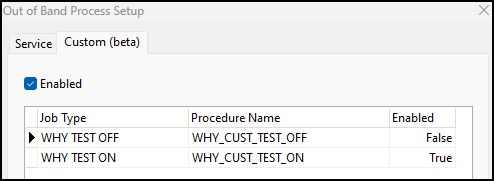
The job system will pick up and process these procedures as long as:
-
They are configured to insert into UTIL_OPS_JOB
-
A process has been configured for the procedure
Here is an example of jobs being submitted by the Out of Band service:

Here is a log showing the jobs being processed and completed:

If you are interested in using this service, contact Trimble Transportation Support to engage Professional Services. If you do not have an account, you can create one by clicking Sign Up.
Allow pieces to be imported into DirectRoute (TM-181835)
Previously, there was no option that allowed pieces to be exported from TruckMate into DirectRoute.
To enable Pieces as an export option, the Appian - Size Type Order app config has been changed. It now has an E type for Pieces.

When you include E as a value for this setting, you can export pieces into DirectRoute.

Pieces are also included when the value is imported back into TruckMate from DirectRoute.
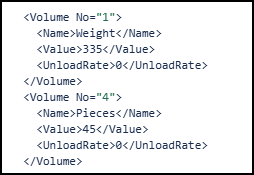
Changes to how the Multi Service option shows terminals (TM-181938)
Previously, the Multi Terminal and Multi Service options in Codes Maintenance did not show records the same way. The Multi Terminal option had a label to show that it had terminals applied to it, but the Multi Service option did not.
Multi Service has been updated so both options work the same way:
-
If no records exist for an option, then no label is shown.
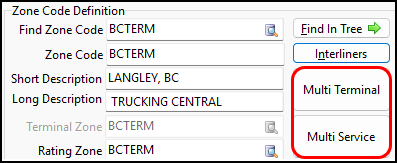
-
If only one record exists for an option, then that zone or service level is shown.
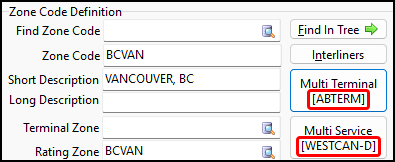
-
If two or more records exist for an option, a numerical value shows how many records there are.
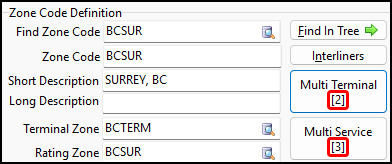
Trip Tracer records search changes (TM-181962)
Changes have been made to the Trip Tracer records search to make sure it does not affect system performance:
-
The option to disable the Limit Search Results to First x Records modifier for the records search has been removed. This prevents Trip Tracer from searching for an unlimited number of records.
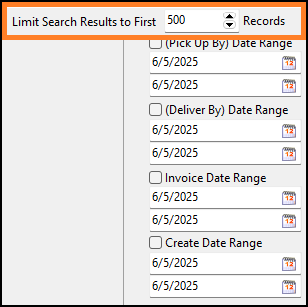
-
The upper limit of the records search has been set to 500. This means that you can only search for up to 500 records at a time.
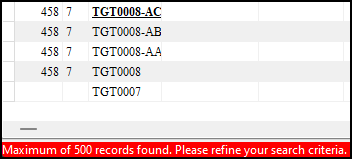
-
The SQL query within the grid has been optimized to ensure a quick result when you begin your trace search.

These changes make sure that Trip Tracer does not lock up your database while doing searches.
Added logic to prevent deadlocks in Out of Band service (TM-182136)
Previously, if you had set up multiple Out of Band services for the same job process, it could lead to deadlocked jobs. Two threads sometimes tried to grab the same record at the same time. This caused certain records to not process as expected.
Logic has been added to fix this issue. Two threads will no longer try to grab the same record at the same time.
Mobile communications
Added the Mobile Communications framework into ART Server Administrator (TM-171243)
Support for the future release of the REST API version of Mobile Communications has been added to ART Server Administrator.
Currently, some MobileComm vendors connect to TruckMate using the SOAP API. However, as TruckMate continues to move toward a REST API model, MobileComm is also moving in that direction.
You can now install the Mobile Communications REST API service. Note that this feature requires license 69300 or 69400.
These endpoints are now available:
-
mobcomm/dailyHours
-
mobcomm/devices
-
mobcomm/positions
-
mobcomm/validate
-
mobcomm/hosLogs
-
mobcomm/hosAvailable
-
mobcomm/trailerSensor
-
mobcomm/reeferSensor
-
mobcomm/trailerAlarm
-
mobcomm/driverLogin
Public documentation for these endpoints can be found by calling the openapi.json endpoint:
-
hostname/mobcomm/openapi.json
Added Send Schedule Changes Only option to PACOS Load Offer window (TM-180520)
Previously, dispatchers had to use the Update Dispatch option to send updated trip changes via the driver workflow. If they forgot to use this option when attempting to update a trip, it could erase all of the progress on a trip.
To avoid this scenario, an option called Send Schedule Changes Only has been added to the PACOS Load Offer window.
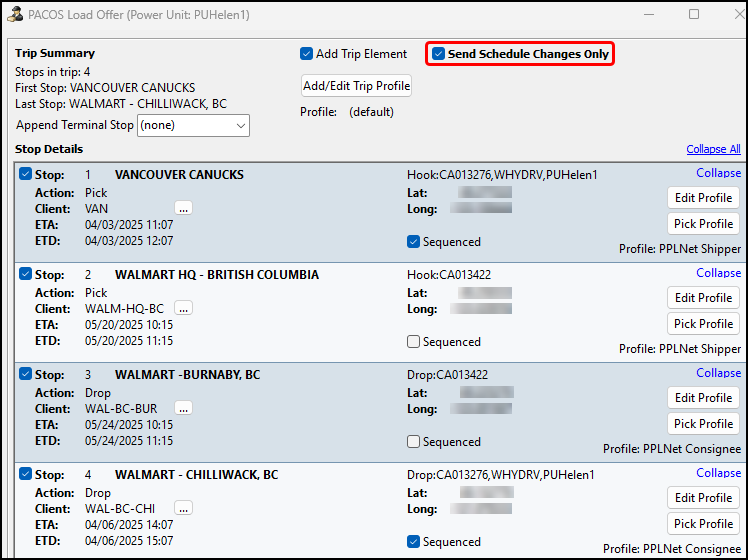
This option updates the workflow instead of replacing it. This allows the dispatcher to update load offers safely. This option is selected by default.
Added option to only apply images to the first freight bill (TM-181151)
Within the D2Link workflow, it was possible for many more photos to be imported into the system than intended.
As an example, if a driver were on a stop with 20 freight bills, and they took a photo and submitted it, TruckMate could receive 400 duplicate photos.
To correct this, an app config has been added called COMMGR.EXE - Apply Images to first Freight Bill only.

This config defaults to False. When set to True, the images taken at a stop are downloaded and saved only to the first freight bill at the stop.
Dispatching operations
Added ability to create planned P&D trips (TM-134122)
In Multi Mode Dispatch, you can now create planned P&D (pickup and delivery) trips.
Previously, when you created trips on the Planning tab, you only had two options: Terminal and Direct. You could not create a planned P&D trip.
The option Local P&D has been added to the Planning tab’s shortcut menu:

Select this option to create a planned P&D trip. As with the other planned trip options, you are prompted to enter a door for the trip. The trip you create follows the same process as a "standard" P&D trip. It is assigned the default route ID assigned to the terminal.
Item barcodes now included in OSD workflow (TM-165437)
You can now define specific barcodes when creating OS&D (Over, Short, and Damaged) records. This change applies to OS&D records created via:
-
Dispatch
-
Multi Mode Dispatch
-
Trip Envelope
-
ConnectedDock
Previously, when you created OS&D claims you could not specify which item the claim was against. When you created an OS&D record, it was created against every detail line on the freight bill.
Now you can define which barcode the claim applies to.
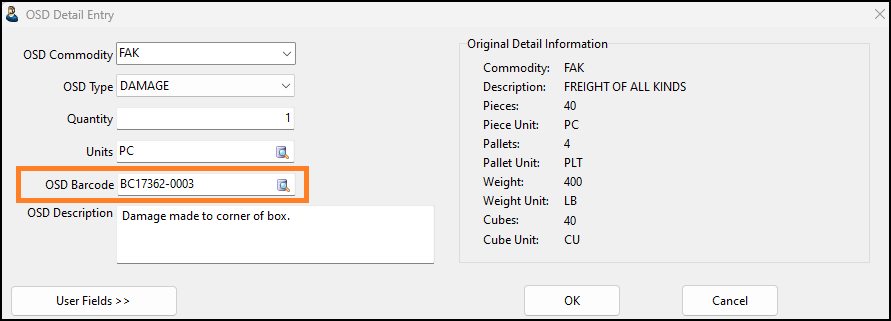
When a record claim is created against a barcoded item, the Load Details grid shows the barcode value of the item.

You can then view the record in Claims. This allows reports to reference specific barcodes for historical tracking.
The new barcode field is optional. If an entire shipment is affected, you can still enter a claim against an entire freight bill by not specifying a barcode.
Added prevention of assignment of bills to trips via checklist items (TM-177397)
You can now require that checklist items be completed before a freight bill can be assigned to a trip. This functionality was only available in Codes Maintenance and ConnectedDock. It is now also available in Dispatch and Multi Mode Dispatch.
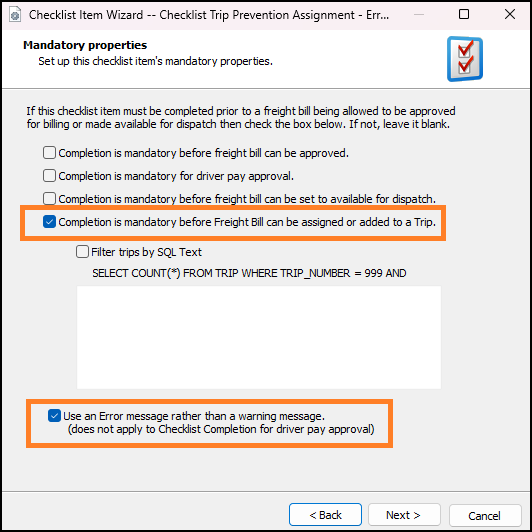
In Customer Service, you will now see a new  warning icon when any incomplete checklist item is outstanding against a freight bill.
warning icon when any incomplete checklist item is outstanding against a freight bill.
This warning icon can also appear on freight bill grids in Dispatch and Multi Mode Dispatch.

However, in Dispatch and Multi Mode Dispatch, the icon only appears if there are any Assignment-based incomplete checklist items. Standard incomplete checklist items do not cause this warning to appear.
In Dispatch and Multi Mode Dispatch, if a user tries to assign a freight bill to a trip that has a checklist item warning, they will get a warning prompt. Select or clear the Use an Error message rather than a warning message option to set whether this warning prevents bill assignment.
If this option is selected, then the user can proceed after getting the warning:
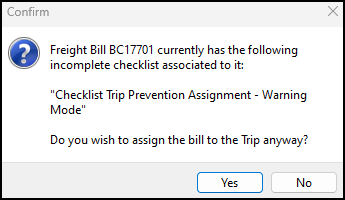
If this option is cleared, then the user cannot proceed after getting the warning:

Added ability to change manual PTA dates (TM-179462)
The default Planned Time of Availability (PTA) time generated by TruckMate is two hours after the Estimated Time of Arrival (ETA) of a trip. As an example, if a resource were set to drop off a trip at 6/24/2025 at 09:00, the PTA would end up being 6/24/2025 at 11:00.
An app config has been added that allows you to choose what time is used to create PTA times. The app config is DISPATCH.EXE - Planned Time of Availability (PTA) Default Time.
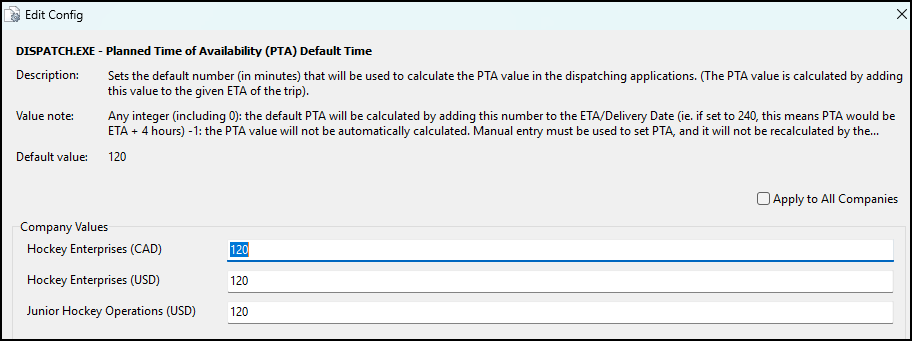
The default value is 120 minutes, which matches the pre-existing logic. You can change this value to any numerical value, with two key callouts:
-
If you enter 0, then the ETA and PTA values will be identical by default.
-
If you enter -1, then the PTA value will not be calculated automatically. With this setting, this field can only be edited by manual intervention from a user. This allows you to set the PTA of your resources manually.
Improved Multi Mode Dispatch performance (TM-181386)
Two changes have been made to Multi Mode dispatch to improve daily performance:
-
An invisible refresh timer has been added to all of the grids. Instead of refreshing whenever it is viewed, each grid now only refreshes if you have been away for more than 20 seconds. This reduces the number of unnecessary refreshes.
-
You can now add multiple SQL and Quick Filters to the same grid at once. You no longer have to wait for the system to refresh after you add each filter.
To do this, hold the CTRL key while adding filters. While you are adding filters, the
 Refresh icon turns red to show that there is a pending refresh to apply the filter. After you have finished adding filters, select
Refresh icon turns red to show that there is a pending refresh to apply the filter. After you have finished adding filters, select  Refresh to load all the filters at the same time.
Refresh to load all the filters at the same time.
Allow searching via all 20 TLDTL User Fields in Trip Tracer (TM-181531)
In Trip Tracer, you can now search for freight bill records from any of the 20 TLDTL User Fields.
To use this feature, select TLDTL User Defined Fields.
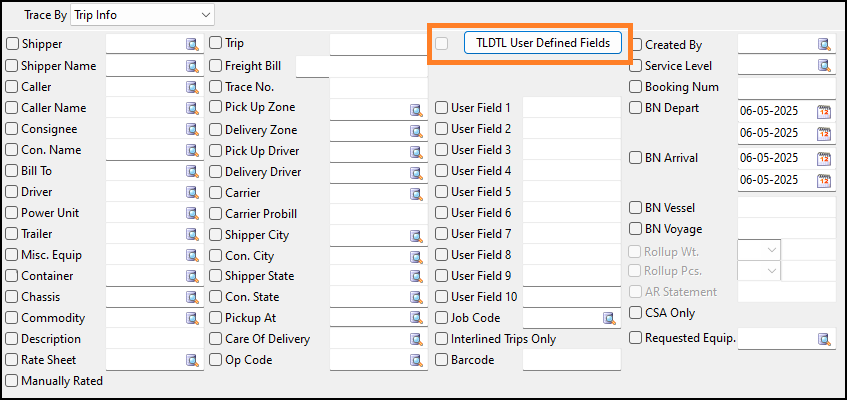
This opens the Edit Load Detail User Fields window.
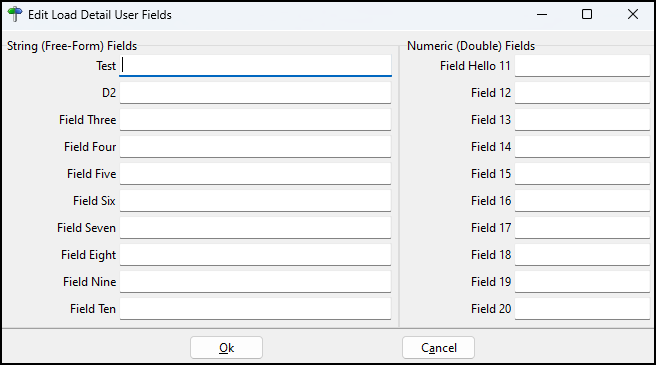
In this window you can search against any of the User Fields to filter freight bills in the system.
Improved the bill number update process (TM-181577)
On the Freight Bill tab in Multi Mode Dispatch, previously when you would select multiple freight bills and then select Update Bill Number, all of the selected bills would clear after you updated the first bill.
Now, after the first bill is updated, only that bill is cleared. The other bills remain selected. The Change Bill Number window now also shows the current freight bill number so you know which bill you are updating.
As an example, in this illustration three bills have been selected. CA013347 is currently being updated:
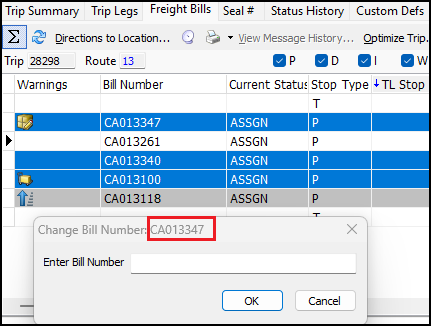
After you select OK, CA013347 is updated (in this example, its number was changed to AA013347). Its row clears, and the Change Bill Number window’s header updates to show the next bill being updated.
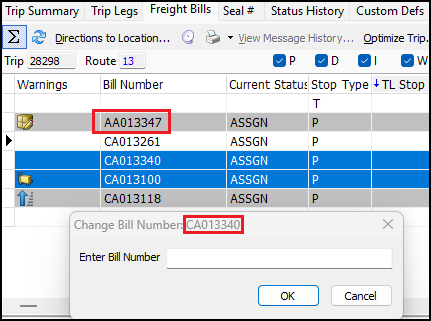
Added security controls to updating bill numbers (TM-182652)
The setting MMDISP - Allow Edit of Bill Number has been added to Security Configuration.
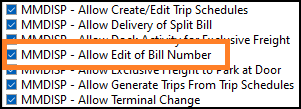
This setting allows you to control which users are able to edit bill numbers in Multi Mode Dispatch. It is selected by default so that existing users are not affected. Clear this option to prevent a user from editing bill numbers.
Added ability to hide bill counts for traps parked at doors (TM-182748)
An option called Show Bill Counts for Traps has been added to the Doors tab in Multi Mode Dispatch.

This option allows you to show or hide the bill counts for traps that are parked at doors. If this option is cleared, the Active Bill Count and Total Bill Count values are hidden.
You may want to hide these values when many traps are present at a terminal to improve system performance.
Added TX Route Seq column to Multi Mode Dispatch (TM-182992)
A TX Route Seq column has been added to the Freight Bills tab of Multi Mode Dispatch.

In Customer Service or on the Pickup or Deliveries tabs of Multi Mode Dispatch, you can define a unique route sequence for freight bills. This route applies at the pickup or delivery level.
In previous versions, when freight bills were added the route sequence value would be used as the actual route sequence. The route sequence would then be structured accordingly. However, in later versions the route sequence was different if the app config MMDISP.EXE > P&D: Auto-Sequence Picks was set to Use Route Sequence. While the bills would still be ordered by route sequence, the actual route sequence value would be replaced with a system-generated one (Stop sequence+1).
The TX Route Seq column returns the ability to see the custom-defined route sequences values. This lets you view the custom defined route sequence against the trip.
Performance enhancements
Performance enhancement to RES_CHANGE_CAPTURE (TM-181742)
The resource change capture process shows changes that were made to resources from third-party systems. It also makes sure any changes are properly recorded and processed. This is only used with a special integration into the product.
Changes have been made to improve this process’s performance. Changes were made to these stored procedures:
-
SP_INS_RES_CHANGE_CAPTURE.SQL
-
SP_TCE_CHECK_ORDER_UPDATE.SQL
-
SP_TCE_CHECK_TRIP_UPDATE.SQL
You should not see any changes to your current workflows as a result of these changes.
Improved performance of DRIVER_MOBILE_ACCOUNT (TM-181826)
Improvements have been made to the DRIVER_MOBILE_ACCOUNT workflow.
In multiple applications, this query was run to return data related to driver mobile accounts:
-
SELECT DRIVER_ID FROM DRIVER_MOBILE_ACCOUNT WHERE ACCOUNT_ID = ? AND ACCOUNT_DRIVER_ID = ?
This led to a full table scan, which often causes poor system performance. Because of this, a new index was added to the system:
-
DRIVER_MOBILE_ACCOUNT_ACCOUNT_DRIVER_ID
Now, when the same query is run, it does an index scan instead of a table scan. This improves response time and overall system performance.
Enhanced WCD_SESSION performance (TM-181899)
A performance improvement has been made to the login workflow for ConnectedDock.
In ConnectedDock, this query was run to return active user data:
-
SELECT DU.USER_ID, DU.FIRST_NAME, DU.LAST_NAME, DU.PASSWORD_HASH, DU.INVALID_LOGIN_ATTEMPTS, DU.LAST_LOGIN, DU.DISABLED, DU.USER_CLASS, DU.HOME_TERMINAL_ID, WS.AUTH_TOKEN FROM WCD_SESSION WS INNER JOIN DOCK_USER DU ON DU.LAST_LOGIN = WS.LAST_ACTIVITY AND DU.USER_ID = WS.USER_ID WHERE WS.USER_ID = ?
This led to a full table scan, which often causes poor system performance. Because of this, a new index was added to the system:
-
WCD_SESSION_UID_UQ
Now, when the same query is run, it does an index scan instead of a table scan. This improves response time and overall system performance.
Enhanced PTLDTL performance (TM-181900)
A performance improvement has been made to the detail line workflow in Order Preprocessor.
In Order Preprocessor, this query was run to return regional restrictions data:
-
UPDATE PTLDTL SET REGIONAL_RESTRICTIONS = ? WHERE (ORDER_ID = ? OR PICK_ID = ?) AND COMMODITY = ?
This led to a full table scan, which often causes poor system performance. Because of this, a new index was added to the system:
-
PTLDTL_COMMODITY
Now, when the same query is run, it does an index scan instead of a table scan. This improves response time and overall system performance.
Enhanced COSTING performance (TM-181905)
A performance improvement has been made to the costing process.
In all active TruckMate databases, the costing process runs in the background. This is done using the COSTING_RECALC_TRIPS table. The COSTING_RECALC_TRIPS record is rebuilt whenever trip information changes on:
-
TLORDER
-
TRIP
-
ORDER_INTERLINER
-
DRIVERPAY
This could affect performance if changes are made to many trips throughout the day.
To address this, a new app config has been added called COSTING.EXE > ReCalcTrip.

When set to True, the costing data continues to process in the background as it did before.
When set to False, the costing data does not run in the background. This improves performance when making updates to trips.
If you do not use costing, Trimble recommends that you set this config to False. This improves system performance.
ConnectedDock
Changes to OS&D photo upload workflow (TM-97137)
Previously, when you took a photo on the OS&D screen in ConnectedDock, you only had one chance to take it. After you took the photo, the image was automatically sent to the imaging location.
This process has been updated in several ways:
-
When you take a photo, it is no longer uploaded immediately. Instead, a thumbnail of the photo appears so you can review it.
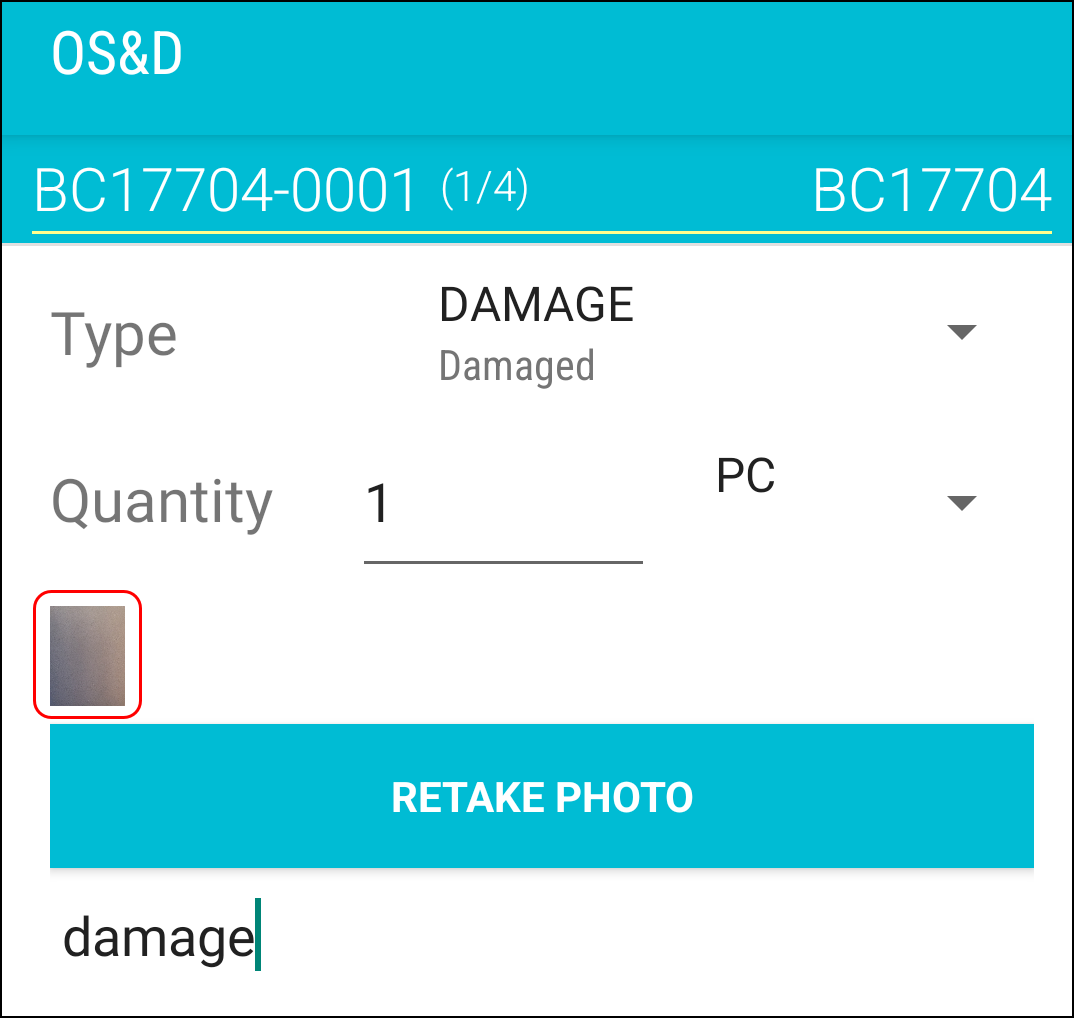
You can select the thumbnail to view the image.
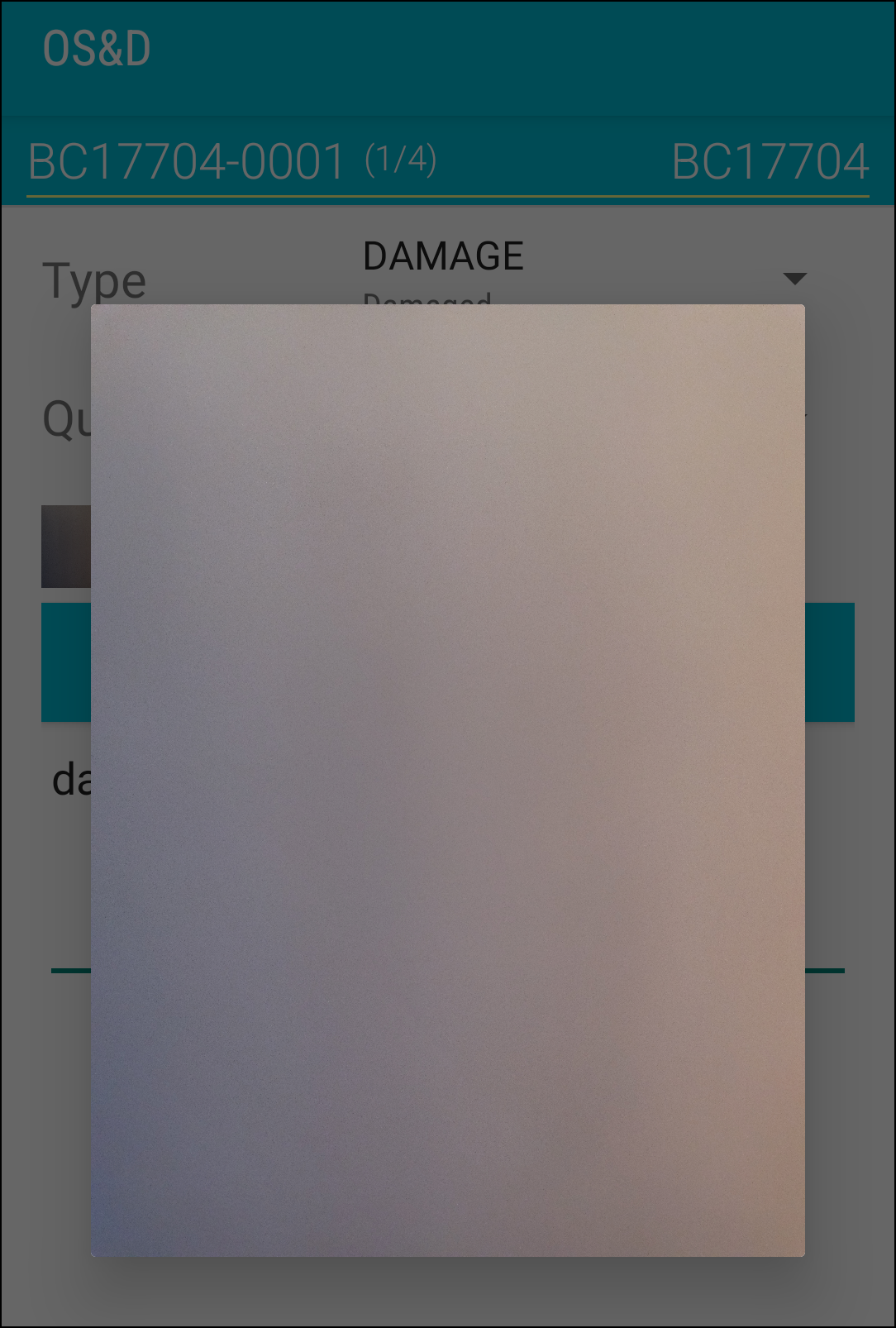
-
If you do not want to use the photo, you can select and hold the image to open an option to delete the image.
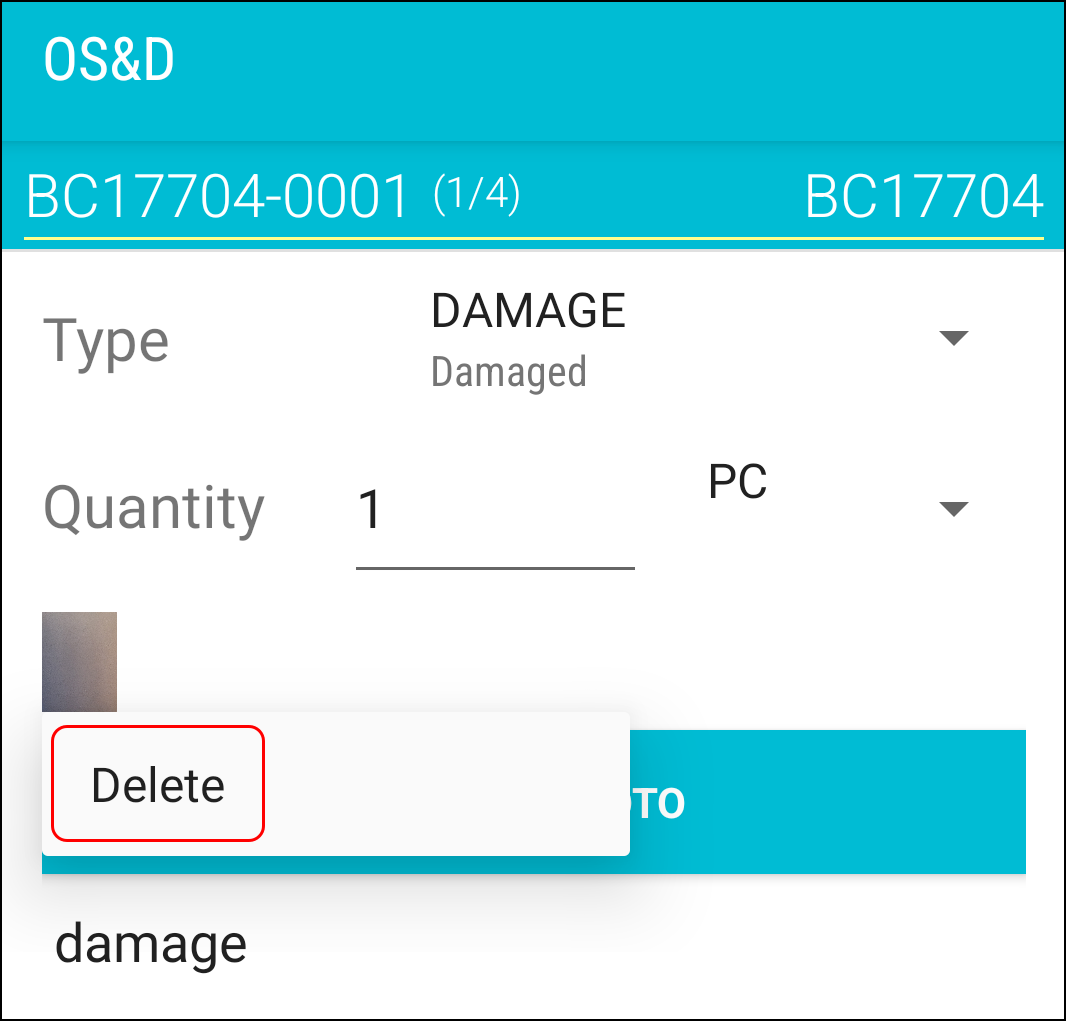
-
If you want to retake the photo, select RETAKE PHOTO.
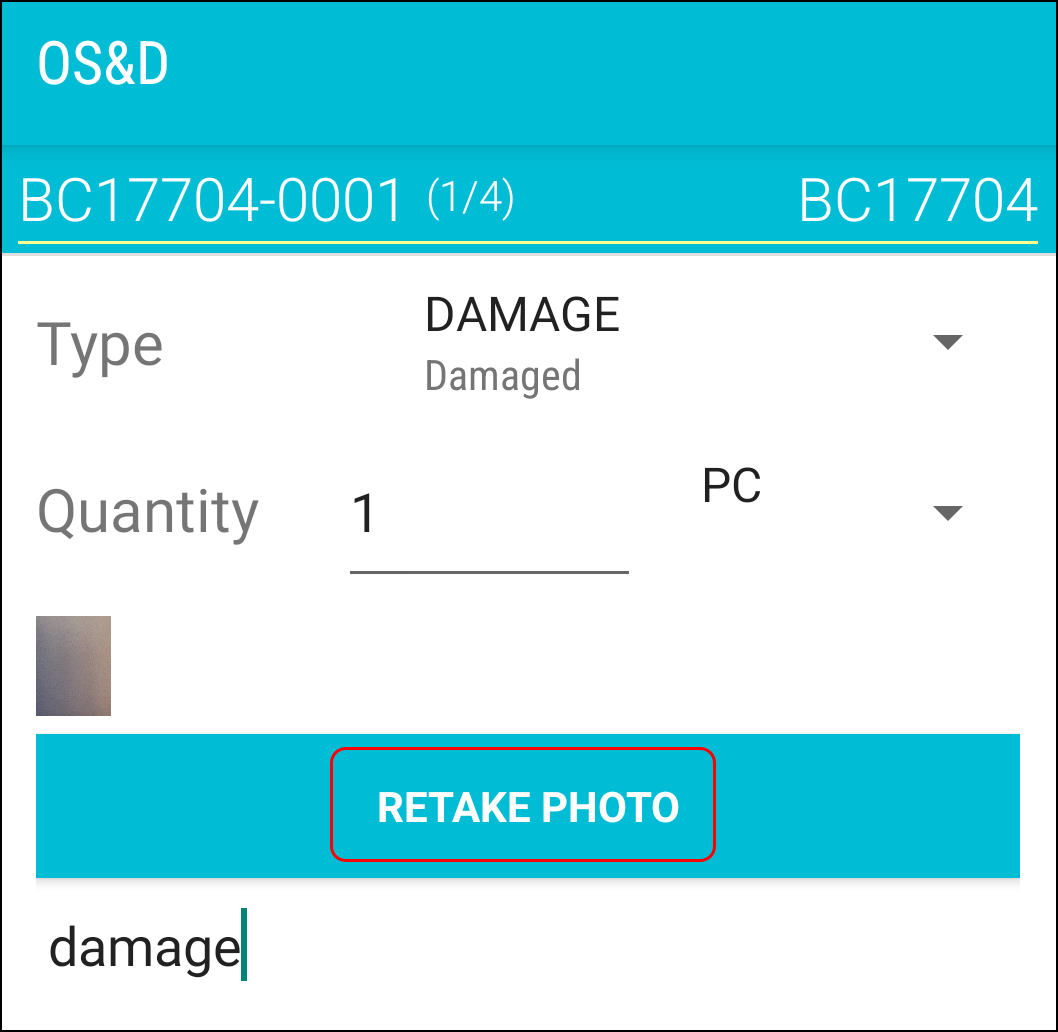
-
When you are ready, you can submit the OS&D record. This will create the new OS&D record and upload the attached image.
Added a freight bill summary screen (TM-150197)
You can now view a freight bill summary in ConnectedDock.
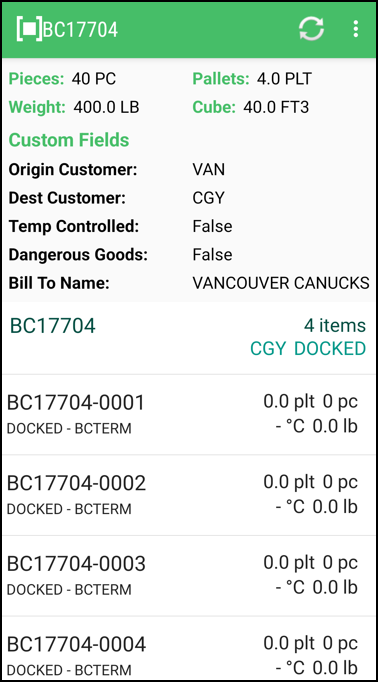
This summary has three sections.
The top section always shows the total values for these freight bill fields:
-
Pallets
-
Pieces
-
Weight
-
Cube

These values are a total of all detail lines on a particular bill. The units displayed include:
-
Any defined ConnectedDock base units
-
If not applicable, any defined default units
-
If not applicable, the "first in the list" approach
The middle section has customizable fields.
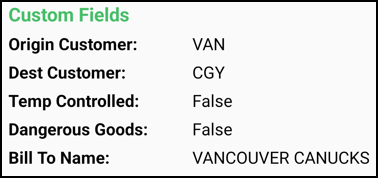
You can choose which fields to assign in ConnectedDock Admin.
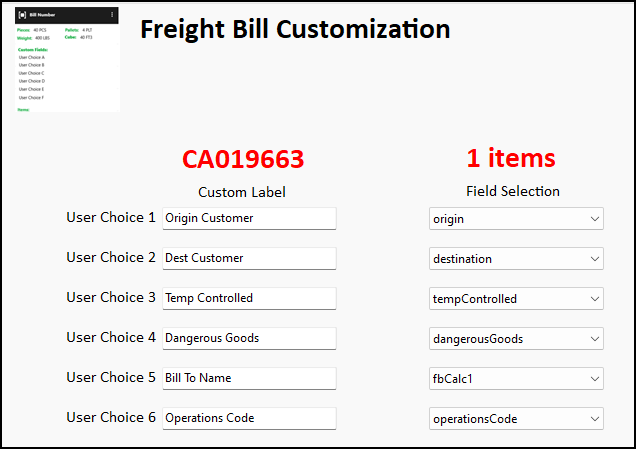
These fields are all from the TLORDER table. You can enter a custom label for any of these fields. The label you enter is the label the field will have on the ConnectedDock app.
The field options are:
-
Origin
-
Destination
-
Service Level
-
Operations Code
-
Deliver By
-
Deliver By End
-
Temperature
-
Temperature Controlled
-
Dangerous Goods
-
Commodity
-
User 1-10
Ten custom fields are also available. These can be updated in the CUSTOM_DOCK_FB_CALC_FIELDS procedure. If you want to display fields beyond these fixed fields, contact Support.
The bottom section shows all the items on the freight bill.
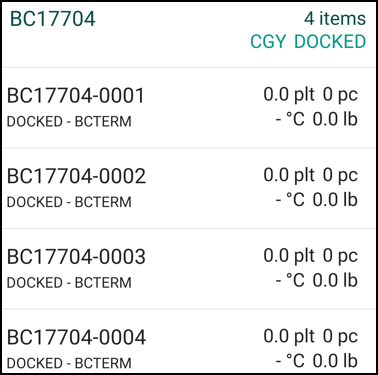
It shows items from multiple detail lines. All items are shown, even if they are in different locations from each other. You can select items to edit their dimensions or move them to different locations.
Added the ability to sign in via QR code (TM-182218)
Support has been added to allow dock workers to sign in to ConnectedDock using a QR code.
There are two different ways to set this up:
-
You can choose to have a singular field set up via QR code. This means you can choose to have either the User, Password, or Hostname populate automatically with a QR code.
-
You can choose to create a full QR sign in for dock workers. With this setup, all the dock worker would need to do to sign in is scan the QR code one time. This would populate all of the fields and sign in the user.
Here is an example of a full QR code that includes all the elements a dock worker would need to sign in.
{ "user": "USERNAME", "password": "PASSWORD", "host": "HOSTNAME" }-
Replace USERNAME with the dock worker’s ID
-
Replace PASSWORD with the password for the ID
-
Replace HOSTNAME with the host name for the ConnectedDock connection.
-
| TruckMate does not have a QR code generator, so you will need to generate your own QR codes to use this feature. |
